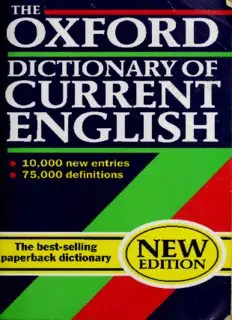
The Oxford Dictionary of Current English PDF
Preview The Oxford Dictionary of Current English
THE OXFORD DICTIONARY OF CURRENT ENGLISH 10.000 new entries 75,000 definitions THE OXFORD DICTIONARY OF CURRENT ENGLISH — — The Oxford Dictionary of Current English SECOND EDITION Editedby DELLA THOMPSON OXFORD UNIVERSITY PRESS 1993 Oxford University Press, WaltonStreet, Oxford0x26dp Oxford New York Toronto Delhi Bombay Calcutta Madras Karachi KualaLumpur Singapore HongKong Tokyo Nairobi DaresSalaam Cape Town Melbourne Auckland Madrid andassociatedcompaniesin Berlin Ibadan OxfordisatrademarkofOxfordUniversityPress Publishedinthe UnitedStatesby OxfordUniversityPressInc.,New York ©OxfordUniversityPress1992 Firstpublished1992aseightheditiono/ThePocketOxfordDictionary FirstissuedasanOxfordUniversityPresspaperback1993 Allrightsreserved. Nopartofthispublicationmaybereproduced, storedinaretrievalsystem,ortransmitted,inanyformorbyanymeans, withoutthepriorpermissioninwritingofOxfordUniversityPress. Withinthe UK,exceptionsareallowedinrespectofanyfairdealingforthe purposeofresearchorprivatestudy,orcriticismorreview,aspermitted undertheCopyright,DesignsandPatentsAct, 1988,orinthecaseof reprographicreproductioninaccordancewiththetermsofthelicences issuedbytheCopyrightLicensingAgency. Enquiriesconcerning reproductionoutsidethesetermsandinothercountriesshouldbe senttotheRightsDepartment, OxfordUniversityPress, attheaddressabove Thisbookissoldsubjecttotheconditionthatitshallnot,byway oftradeorotherwise,belent,re-sold,hiredoutorotherwisecirculated withoutthepublisherspriorconsentinanyformofbindingorcover otherthanthatinwhichitispublishedandzvithoutasimilarcondition includingthisconditionbeingimposedonthesubsequentpurchaser BritishLibraryCataloguinginPublicationData Dataavailable LibraryofCongressCataloginginPublicationData — TheOxforddictionaryofcurrentEnglish/editedbyDelia Thompson. 2nded. — p. cm.— 1. Englis—hlanguage 20thcentury Dictionaries.2.English language Newwords—Dictionaries. I. Thompson,DeliaF. PE1628.0867 1993 423'.l-dc20 92-27280 CIP ISBN0-19-283127-5 3 5 7 9 10 8 6 4 PrintedinDenmark byNorhavenRotation Contents Guide totheUseoftheDictionary vii Abbreviations usedintheDictionary xii Pronunciation Symbols usedintheDictionary xiv DICTIONARY 1 Appendix: PunctuationMarks 1072 Editorial Staff ManagingEditor DrDeliaThompson GeneralEditors MrAndrewHodgson MrChrisStewart ScienceEditor DrAlexandraClayton FreelanceEditors MrsBarbaraBurge MrsAnnaHowes MsLouiseJones CriticalReaders DrI. Grafe MrM. W. Grose KeyboardingManager MrsAnneWhear KeyboardingAssistants MrsPamMarjara MrsKayPepler MissDoreenStanbury Proofreadersand MrsDeirdreArnold GeneralContributors MrKeithHarrison MrRichardLindsay MsElizabethMcllvanney DrBernadettePaton MsLucyReford DrAnneStJohn-Hall MsJoannaThompson MrF. RolandWhear Thiseditionowesmuchinitscontentandstyletotheeightheditionof the Concise Oxford Dictionary edited by Dr Robert Allen, who also revisedtheetymologiesforthisdictionary. Guide to the Use of the Dictionary Headword 1. 1.1 Theheadwordisprintedinboldtype, orinbolditalictypeif the word is not naturalized in English and is usually found in italics inprinted matter. 1.2 Variantspellingsaregivenbeforethedefinition(e.g.cabbyn. (alsocabbie));inallsuchcasestheformgivenastheheadwordis the preferred form. When the variant form is alphabetically remote from the main form it is given at its proper place in the dictionary(e.g. caimanvar. ofcayman). 1.3 Wordsthataredifferentbutspeltthesameway(homographs) are distinguishedbysuperiorfigures (e.g. bat1 andbat2). 1.4 Wordsthatarenormallyspeltwithacapitalinitialaregiven inthisformastheheadword; whentheyareinsome sensesspelt with a small initial and in others with a capital initial this is indicated by repetition ofthe full word in the appropriate form withintheentry(asatcarboniferous). 1.5 VariantAmericanspellingsareindicatedbythedesignation US(e.g. favour. . . USfavor). 2. Pronunciation GuidanceonpronunciationfollowsthesystemoftheInternational Phonetic Alphabet (IPA). Only the pronunciation standard in southernEnglandisgiven. Akeytothesymbolsusedappearson pagexiv. 3. Part-of-speechlabel 3.1 Thisisgivenforallmainentries andderivatives. 3.2 Differentpartsofspeechofasinglewordarelistedseparately. 3.3 Verbs,whethertransitive,intransitive,orboth,aregiventhe simpledesignationv.Thedesignationabsol.(absolute)denotesuse withanimpliedobject(asatabdicate). 4. Inflexion 4.1 PluralsofNouns: Nouns that form their plural regularly by adding -s (or -es when viii GUIDE TO THE USE OF THE DICTIONARY they end in -s, -x, -z, -sh, or soft -ch), receive no comment. Plural forms of those ending in -o (preceded by any letter other than anothero)arealwaysgiven.Otherirregularformsarealsogiven, except when the word is a compound ofobvious formation (e.g. footman, schoolchild). 4.2 FormsofVerbs: 4.2.1 Thefollowingregularformsreceivenocomment: (i) third person singularpresentforms adding-stothe stem (or -estostemsendingin-s, -x, -z, -sh, orsoft-ch). (ii) pasttensesandpastparticiplesadding-edtothestem. 4.2.2 A doubled consonant in verbal inflexions (e.g. rubbed, rubbing, sinned, sinning) is shown in the form (-bb-, -nn-, etc.). WherepracticediffersinAmericanusagethisisnoted(asatcavil). 4.3 Comparative and Superlative of Adjectives and Adverbs: Thefollowingregularformsreceivenocomment: 4.3.1 Words of one syllable adding -er and -est (e.g. greater, greatest). 4.3.2 Words ofone syllable ending in silent e, which drop the e andadd-erand-est(e.g. braver, bravest). 5. Definition 5.1 Definitionsarelistedinorderofcomparativefamiliarityand importance, withthemostcurrentandimportantsensesfirst. 5.2 Theyareseparatedbyanumber,orbyaletterwhenthetwo sensesaremorecloselyrelated. 5.3 Roundbracketsencloselettersorwordsthatareoptional(as at crash v. where '(cause to) make a loud smashing noise' can meaneither'makealoudsmashingnoise'or'causetomakealoud smashing noise'), and indicate typical objects oftransitive verbs (suchas 'milk' and 'theskin' intwosensesofcream v.). 6. SubjectandUsagelabels 6.1 These are used to clarify the particular context in which a wordorphraseisnormallyused. 6.2 WordsandphrasesmorecommonininformalspokenEnglish than informalwrittenEnglishare labelledcolloq. (colloquial) or slangasappropriate. GUIDE TO THE USE OF THE DICTIONARY ix 6.3 Some subject labels are used to indicate the particular relevanceofatermorsubjectwithwhichitisassociated(e.g.Mus., Law, Physics). They are not used when this is sufficiently clear fromthedefinitionitself. 6.4 Two categories ofdeprecated usage are indicated by special markings: coarse slang indicates a word that, although widely found, is still unacceptable to many people; offens. (offensive) indicates a use that is regarded as offensive by members of a particularethnic, religious, orothergroup. 6.5 Usagenotesfoundattheendofentries give guidanceonthe current norms ofstandard English. Some ofthe rules givenmay legitimately be broken in less formal English, and especially in conversation. 7. Phrases Phrasesarelistedinalphabeticalorderafterthetreatmentofthe main word. The words a, the, one, and person do not count for purposesofalphabeticalorder. Compounds 8. 8.1 Compound terms forming one word (e.g. bathroom, jellyfish) are listed as main entries, as are those consisting of two or more words (e.g. chain reaction) orjoined by a hyphen (e.g. chain-gang). 8.2 Whenahyphenedcompoundinboldtypeisdividedattheend ofalinethehyphenisrepeatedatthebeginningofthenextlineto showthatitisapermanentfeatureofthespellingandnotjustan end-of-linehyphen. 9. Derivatives 9.1 Wordsformedbyaddingasuffixtoanotherwordareinmany cases listed at the end of the entry for the main word (e.g. chalkiness and chalky at chalk). In this position they are not defined since they canbe understoodfrom the senseofthe main word and that given at the suffix concerned; when further definition is called for they are given main entries in their own right(e.g. changeable). 9.2 Forreasonsofspacewordsformedbycertainsuffixesarenot always included except when some special feature ofspelling or
